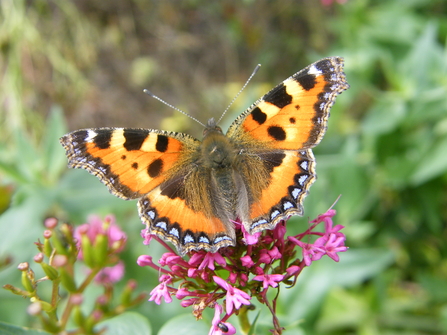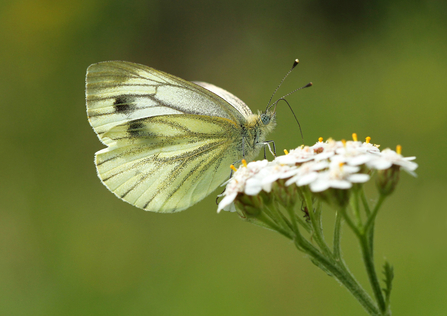June is the time of enjoying fragrant, blooming flowers in your garden – but also butterflies, our flying flowers! Here are some fluttering beauties to look out for this month, as well as ways to encourage them to visit your patch of green.
What to See in June
The Peacock is a large butterfly, with a wingspan of 6.3–7.5cm, and it can be seen year-round. However, it is especially active in the summer months. It can be seen in your garden (especially if you have Buddleia), along woodland rides and in woodland clearings, in parks and on our reserves, such as Alpine Meadow, near Berkhamsted. It lays its eggs on Stinging Nettle, which the caterpillars eat. The striking ‘eye’ patterns on the front of its forewings (which are reminiscent of a Peacock’s feather) are there to deter predators.

The Small Tortoiseshell is so called because of the yellow and black stripes at the top of its forewings. All four of its wings are edged with blue half-ovals. Despite these glorious colours, this butterfly shuts its wings when at rest – then resembling a dead leaf. The Stinging Nettle is also vital to this butterfly for egg laying (in batches up to 100), and as food for its black and yellow striped spiny caterpillars. The caterpillars live together in colonies, within protective silken tents. So why not have a patch of Stinging Nettles in your garden?

Holly Blue ©Amy Lewis
If you fancy bringing an enigmatic flash of bright blue to your garden, consider planting Holly and Ivy (or letting them grow if you have them already). The Holly Blue butterfly will thank you for it! This diminutive butterfly has a wingspan of 2.6–3.4cm. Its spring generation relies on Holly, and its summer generation on Ivy. It also appreciates a wide range of other plants such as the hot pink and orange Spindle, as well as Bramble and Gorse. The Holly Blue can be distinguished from the other blue butterflies by the black spots on its silvery-blue underside (the others have orange spots there).

©Jon Hawkins
The Green-veined White butterfly looks similar to the other white butterfly species, except that it has prominent green stripes on the undersides of its wings. It has a wingspan of 4–5cm, with black wingtips and one or two black spots on its forewing. Found along hedgerows and woodland rides, in meadows, gardens, parks and on farmland, this butterfly favours damp areas with lush vegetation. Its caterpillars feed on plants within the cabbage family, including Cuckooflower and Hedge Mustard. This butterfly will also appreciate you having Ivy in your garden, in which it can overwinter.
To help you identify the butterflies you see this summer, download our butterfly spotter’s guide here. You could do this as part of 30 Days Wild’s theme for Week 1, ‘Discover Nature’!
Learn how to attract butterflies to your garden here, and do some nature-friendly planting as part of 30 Days Wild’s theme for Week 3, ‘Help Nature’. For example, you could get yourself a stunning Buddleia bush, beloved by most butterflies, and grow Ivy and Holly bushes to help all overwintering butterflies and insects. Sizeable ones can also be used by birds to nest in! A patch of Stinging Nettles in your garden will give several species of butterfly somewhere to lay their eggs, and their caterpillars a place to shelter and feed.
30 Days Wild is an initiative that encourages everyone to do something wild and mindful each day in June. For more info and to get your free pack, sign up before 16 June here.

